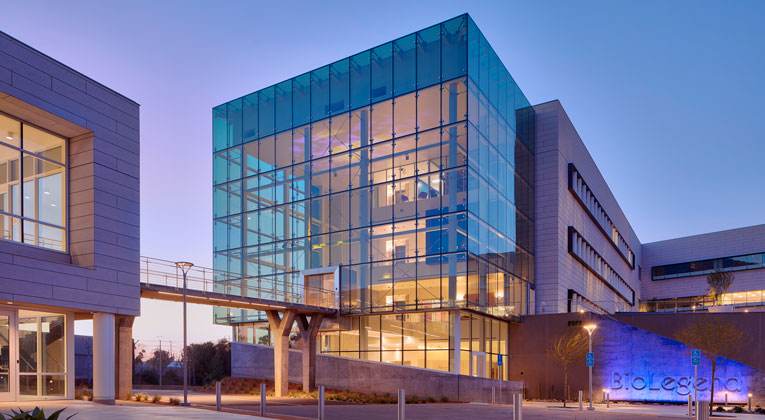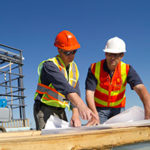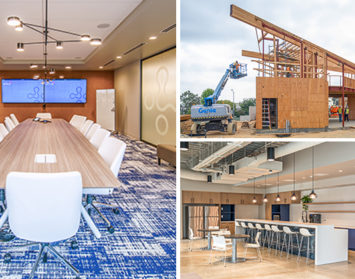After four years of planning, design, permitting and construction, the BioLegend Campus is complete and was delivered an unprecedented three days ahead of the original schedule and 2% under the original budget.
The eight-acre BioLegend Campus includes a myriad of intricacies and subtleties. Encircling the buildings is over 200,000 square feet of site improvements of meandering sidewalks and vast hardscape depicting circles that designate communal and outdoor meetings spaces. Located amongst the site improvements are five structures ranging in use from biology and chemistry labs, administrative office space, a kitchen with serveries, multipurpose rooms, a spanning atrium, a hidden parking structure and, finally, to an automated distribution center.
The process was efficient. The team was proactive. The owner was committed. The story goes like this:
“We’re growing. I need a little more lab space.” These are the famous words Founder, Dr. Gene Lay, remembers saying to Hughes Marino Executive Vice President David Marino in 2015. The conversation evolved into a topic of strategy, longevity and commitment. For Dr. Lay and his executive team, expansion wasn’t an idea—it was a commitment to their team and the research community. Starting with the site search and master planning, the Hughes Marino life science real estate team embarked on creating a strategic Master Plan that outlined a road map for success.
Land Acquisition & Entitlements
Hughes Marino sourced the land by reverse engineering the traditional real estate process. Traditionally, you would cast a wide net across a geographic region based on a size range. In this case, the team targeted value and favorable entitlements. The search uncovered a number of opportunities but one area specifically spoke to BioLegend. The 7.2-acre, four parcel campus with four existing buildings fed by Terman Court was located just outside the strict MCAS overlay zone and included the zoning and by right entitlement BioLegend hoped for.
Before diving into the entitlement jargon, it’s important to note that while this project is specific to the City and County of San Diego, similar nomenclature is used in other parts of the country.
The due diligence period started with entitlement and zoning research which uncovered the By Right designation and a favorable floor-to-area ratio, or FAR. The By Right designation means you can build a certain usage by right as long as you stay within the original, or previously approved, development standards.
In this case, BioLegend could build over 500,000 net square feet of research and development use on the four parcels. However, in order to completely tie the parcels together to fully utilize the efficiency of the space, Hughes Marino would need to vacate (privatize) Terman Court, which would require a 16-month entitlement process through City Council. These three details laid the groundwork to solicit proposals from architecture and planning firms to help to create the documents for the Master Plan and exhibits to approach the City of San Diego for a Preliminary Design Review.
The local San Diego architecture firm, Delawie, and local planning firm, Latitude 33, was selected through a competitive bid and interview process. After only three months of Due Diligence and Master Planning, Hughes Marino and the team presented the Master Plan to BioLegend, who approved the first two phases. The table below outlines the Guiding Principles and Phases of the Master Plan:
Master Plan Guiding Principles
1. Budget: Ensure the project remains on budget.
2. Quality: Create an efficient and functional campus that encourages research, discovery and employee retention.
3. Value: Form follows functions.
4. Sustainability & Opportunity: Design for the future.
5. Future Events: Host BioLegend Campus Inauguration Symposium on May 8th, a day before American Association of Immunologists 2019 Annual Meeting at the San Diego Convention Center.
Approved Phases
Phase 1: Convert existing building at 8959 Terman Court into a lab building (Tenant Improvement Project)
Phase 2: Street vacation of Terman Court (Privatize Terman Court)—Process 5 through City Council
Phase 3: Campus project to include a new lab building, tenant improvement and reskinning existing building at 8928 Terman Court. New parking structure to accommodate increased headcount, automate order fulfillment process and site improvements.
Phase 4: Convert existing Building at 8929 Terman Court into lab building or incubator space.
The two renderings below compare the original Master Plan site plan to the approved Master Plan site plan:
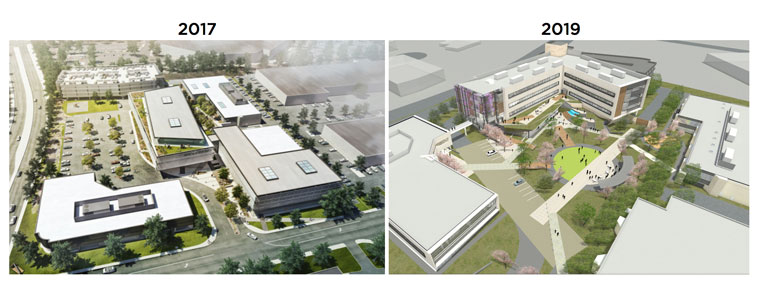
Phasing & Approvals
Phases 1 and 2 were completed simultaneously, then once the plans for Phase 1 were submitted to the City of San Diego’s Development Services for initial plan check, Hughes Marino reviewed the Master Plan with BioLegend who then approved to move onto Phase 3. The simple bar graph below highlights how the team overlapped the phases:

Design
BioLegend wanted the design to be holistic, functional and well thought-out. The phasing became intentional. In a project of this magnitude there are four factors: time, budget, design and efficiency. They all tend to work hand-in-hand so to sacrifice one is to sacrifice them all.
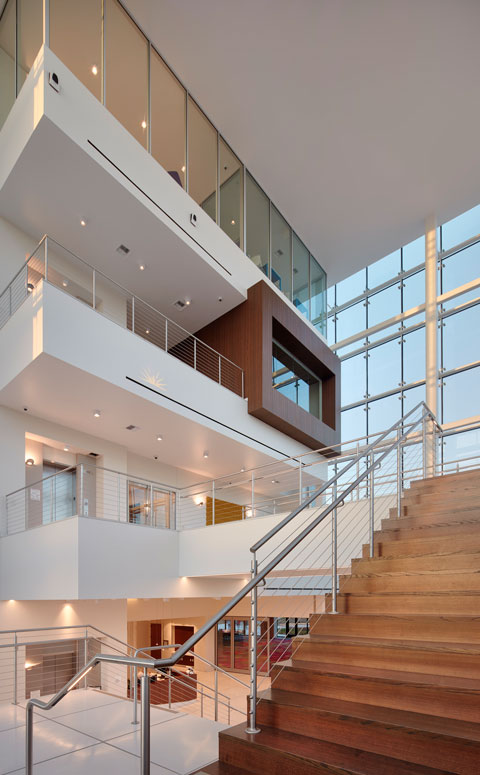
Phases 1 and 2 started concurrently, but finished nearly seven months apart. Phase 1 was completed on time and under budget in October 2016 and Phase 2 was successfully processed in April 2017—one day ahead of schedule. As a side note, when Phase 2 was successfully processed, BioLegend captured just under one acre of land, increasing their Campus acreage to just over 8-acres.
Since we kicked off the design for Phase 1 at a time when Delawie’s time commitment to Phase 1 was becoming more manageable, it afforded them the time and resources to focus on establishing a thorough Schematic Design Package. The Schematic Design Package helped Hughes Marino solicit proposals from local general contracting firms and for Delawie to work with the Phase 3 civil engineer, San Dieguito Engineering, Inc., on producing a Rough Grading Package ahead of submitting the Phase 3 plans to the City of San Diego for a building permit.
DPR Construction was selected through a competitive bid and interview process. The Rough Grading Permit was issued in April 2017 at the same time Phase 2 was approved by City Council, and the Demolition Permit was issued in July 2017. The Building Permit for Phase 2 was issued in October of 2017.
Budget, Cash Flow & Procurement
Phase 3 made up more than 50% of the Master Plan budget so the procurement process had the ability to make or break the entire Master Plan budget. With DPR Construction on board, Hughes Marino managed the design process to coincide with the pre-construction efforts. The efforts were cohesive and incredibly proactive.
Hughes Marino included milestone design dates in the Phase 3 schedule then gave DPR Construction time to update their preliminary budgets to ensure the design was meeting Goal #1: Ensure the project remains on budget. While DPR Construction updated their budgets, Delawie and the additional consultants updated their designs on items that would not be impacted by value engineering activities, if required.
The team agreed to phase subcontractor buyout so the project team could do its part to manage the increasingly busy subcontractor market. Speaking specifically to the labor shortage, by late 2017 the construction industry was historically busy. Starting the process early afforded the team the ability to insert bidding opportunities in qualified subcontracting firms’ schedules or expand the subcontractor pool in the event multiple firms rejected the opportunity–which ended up happening.
Additionally, no one on the team could guarantee how the global economy was going to react to the political climate, specifically speaking to the hard commodities markets including oil prices, steel and finished goods, as they were a cause for concern. For example, in focusing on steel prices, while we could procure steel domestically, potential tariffs gave impacted and non-impacted companies a reason to increase pricing. Comparable examples could be made on other construction materials such as concrete, flooring and manufactured glass.
By this time, Phases 1 and 2 were complete. How the team bought-out the Phase 3 subcontractor costs supported the original cash flow projections that Hughes Marino had proposed during the original Master Plan.
Here’s a quick graph that outlines how the cash flow as a percentage of the total project budget compared to the Master Plan Schedule and Phasing:
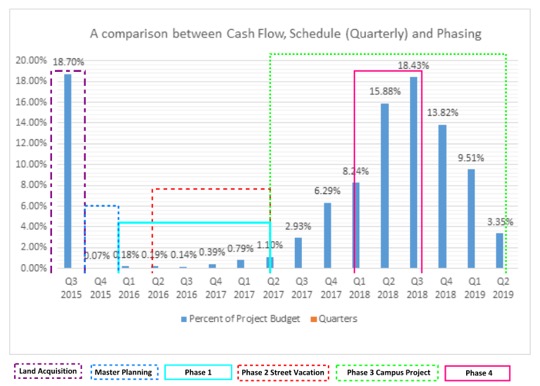
Campus Project Construction, Phase 4 & Order Fulfillment
8958 Terman Court, the existing building at the Northwest corner parcel, was torn down while 65% of the entire site was turned into a sandbox. Once grading was complete, DPR Construction phased excavation so all areas of the site could be accessed, meaning, the open footings wouldn’t bifurcate the site in a way of limiting access and efficiency.
As DPR was finishing digging out the footings for the new 130,000 square foot building at the center of the Campus, the ground floor columns at the parking structure were set in place. Meanwhile behind the scenes, Hughes Marino was working with the BioLegend team to design an automated Order Fulfillment operation in the future shipping and receiving warehouse.
So DPR Construction, the subcontractors and design team could focus on maintaining the schedule, Hughes Marino’s Program, Project and Construction Management team compared the construction schedule to onsite production work, and overlaid the column layout with the proposed automation system layout.
Before column footings were poured, Hughes Marino laid out the plan to the design and construction team, and confirmed the layout coincided with the columns and overhead infrastructure. The Order Fulfillment operation was successfully coordinated and completed with the rest of the Campus Project.
By January of 2018, DPR Construction was off to the races and all design decisions had been made on the Campus Project which meant the BioLegend team went from attending multiple design meetings to watching their headquarters come out of the ground in front of their eyes.
At the beginning of 2018, BioLegend approved Phase 4 to design, engineer and build out the first floor of 8929 Terman Court, the Southeast corner building and the only remaining building on the Campus. Design and engineering kicked off in early February and by mid-September, BioLegend was operating in their new proteogenomics lab.
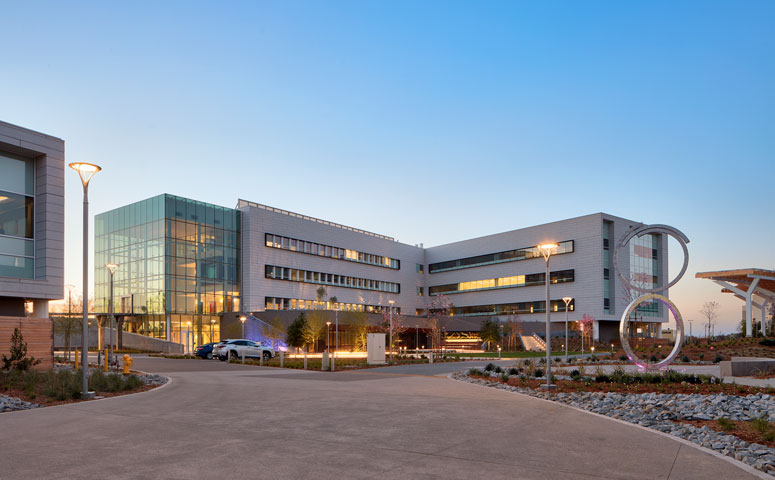
The Final Push
With three months left on the Project Schedule and the finish line in sight, the Phase 3 Project Team looked to finish their project strong. The Phase 3 Project finished one day ahead of schedule and under budget. To add to the excitement, each project included in the Master Plan finished on or ahead of schedule, and after all financials were reconciled it was determined the project complete approximately 2% under the original budget.
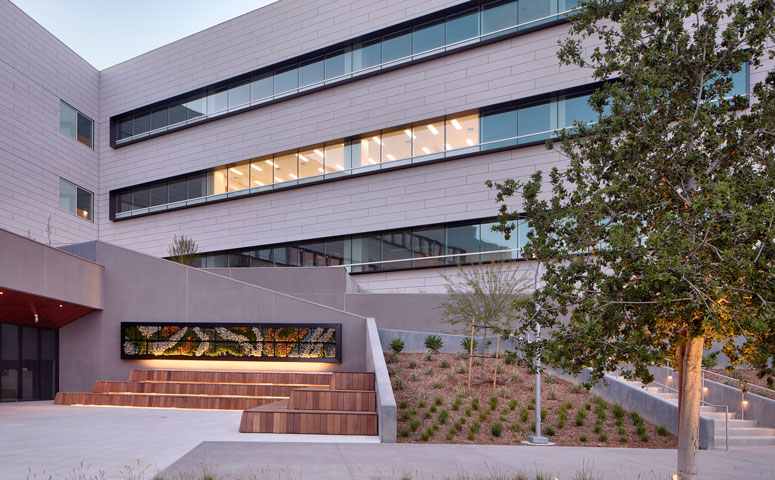
BioLegend was especially proud to host the BioLegend Campus Inauguration Symposium at their new World Headquarters on May 8th, the day before the American Association of Immunologists Annual Meeting in San Diego where BioLegend invited over 500 World-Renowned Immunologists and industry professionals. The Symposium included talks by five world-renowned immunologists, including 2018 Nobel Laureate, Professor James P. Allison, PhD.
Congratulations to BioLegend on this amazing achievement!
Project Award
2019 Best Projects Awards from Engineering News-Record in the Manufacturing category–ENR California Region
Project Team Members
Owner: BioLegend
Owner’s Representative/Construction Manager: Hughes Marino
Architect: Delawie
General Contractor: DPR Construction
Planner: Latitude 33
Mechanical and Plumbing Engineer: DEC Engineers
Electrical Engineer: ELEN Engineering
Structural Engineer: Coffman
Fire, Life Safety and Hazardous Material Consultant: Jensen Hughes
Order Fulfillment: Bastian Solutions
Civil Engineer: San Dieguito Engineering
Furniture: Cultura
Landscape Architect: Schmidt Design Group
Hughes Marino’s industry leading Construction Management team has unmatched expertise in every type of commercial building project from tenant improvements to ground-up build-to-suits. With decades of experience in California and beyond, our project managers, engineers and LEED APs offer practical insights for the construction management professional.

